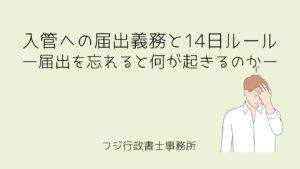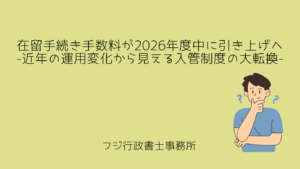移民国家化の入口へ
日本における外国人労働者の受入れ状況は、近年急速に変化しています。これまで政府は「移民政策は取らない」という立場を維持してきましたが、現実には労働力不足への対応を背景に、制度面でも運用面でも大きな転換点を迎えています。とくに2019年の入管法改正で新設された「特定技能」制度以降、外国人労働者の数は増加し、受け入れ分野も拡大の一途をたどっています。こうした動きは、表向きの言葉では「移民」ではないとしても、実態としては移民国家化への道を進みつつあると見る専門家も少なくありません。
少子高齢化が進行する中、日本の労働市場は多くの業種で慢性的な人手不足に直面しています。とくに介護、建設、製造、農業、サービス業といった分野では国内の労働力だけでは賄いきれず、外国人労働者に頼らざるを得ない構造になっています。政府が制度を拡充する背景には、こうした経済・社会的な現実があります。
The situation regarding the acceptance of foreign workers in Japan has been changing rapidly in recent years. Although the government has consistently stated that it does not adopt an “immigration policy,” in reality both the legal framework and administrative practices have undergone major shifts in response to labor shortages. Since the 2019 Immigration Control Act revision and the introduction of the “Specified Skilled Worker” status, the number of foreign workers has increased significantly, and the fields open to them have expanded steadily. While this may not be officially labeled as “immigration,” many experts view these developments as clear steps toward becoming an immigration country.
With a rapidly aging and shrinking population, Japan’s labor market is facing chronic shortages across many industries. Fields such as caregiving, construction, manufacturing, agriculture, and service sectors cannot be sustained by domestic workers alone. The expansion of foreign labor policies is a direct response to these economic and social realities.
政策の変遷と転換点
外国人労働者受け入れの制度は、当初は「高度人材」と呼ばれる専門職や技術職を対象にしていました。いわゆる「技術・人文知識・国際業務」や「高度専門職」といった在留資格がそれにあたります。しかし、1990年代以降、研修・技能実習制度が整備され、製造業や農業といった分野にも外国人が入る道が開かれました。とはいえ、技能実習制度は本来「国際貢献」が目的とされ、労働者ではなく「実習生」という建て付けで運用されてきました。
転換点となったのは、2019年の入管法改正です。特定技能1号・2号の創設によって、外国人が労働者として正面から受け入れられる仕組みが整いました。とくに特定技能2号では、家族の帯同も認められており、長期的な定住・移住の可能性が開かれています。これは、従来の「一時的な滞在者」という位置づけから大きく踏み出したものといえるでしょう。
さらに、2023年以降は技能実習制度を廃止し、新たに「育成就労制度」への移行が進められています。これにより、受け入れ側の企業や監理団体の責任がより明確になり、労働者としての権利保護も強化される方向にあります。つまり、日本の外国人労働者受け入れ政策は、制度設計の面でも「労働力としての受け入れ」を明確化する方向に転換しているのです。
Initially, Japan’s foreign labor acceptance system targeted so-called “highly skilled” professionals and technical workers through statuses such as “Engineer/Specialist in Humanities/International Services” and “Highly Skilled Professional.” From the 1990s onward, however, the trainee and Technical Intern Training Program was introduced, creating a path for foreign nationals to work in manufacturing, agriculture, and other sectors. Officially, this system was framed as “international contribution,” not labor importation, and participants were treated as trainees rather than workers.
The real turning point came with the 2019 Immigration Act revision, which introduced the Specified Skilled Worker (Type 1 and Type 2) statuses. This marked the first time foreign nationals were explicitly accepted as workers. Notably, Type 2 allows family accompaniment, paving the way for long-term settlement and migration. This represented a major departure from the previous framework of “temporary stays.”
Furthermore, from 2023 onward, Japan began phasing out the Technical Intern Training Program and shifting toward a new “Development Employment System.” This change places greater responsibility on host companies and supervisory organizations and strengthens worker protections. In short, Japan’s foreign labor acceptance policy is moving toward a clearer, more explicit system of accepting foreign nationals as part of the workforce.
実態としての移民化と社会の変化
制度が整うにつれて、外国人労働者の数も着実に増えています。厚生労働省の集計によれば、日本で働く外国人労働者は過去10年間で2倍以上に増加し、現在では200万人規模に達しています。これは単なる労働力補完ではなく、社会構造そのものを変えつつある数字です。とくに特定技能制度を利用する人々は、一定の日本語能力と技能を備えた層であり、単身労働者だけでなく、将来的に家族と共に定住を目指す人々も増えています。
地方自治体の現場でも変化が顕著です。これまで都市部に集中していた外国人労働者や移民が、介護や農業分野を中心に地方にも広がりつつあります。地域社会の側も、言語支援や生活相談窓口、学校での日本語教育といった受け入れ体制の整備を進めざるを得なくなっています。例えば、地方の中小企業では、外国人材がいなければ事業が回らない状況も珍しくありません。こうした受入れ状況の変化は、単なる労働政策ではなく、地域社会全体のあり方を左右する問題になっています。
一方で、受け入れが進む中で課題も浮き彫りになっています。言語や文化の違いによる摩擦、雇用契約や労働環境の不備、不十分な生活支援などが社会問題化するケースもあります。とくに技能実習制度のもとでは、低賃金や過酷な労働条件といった問題が国内外で批判されてきました。今後、移民としての定住が進むとすれば、単なる労働力の受け入れではなく、社会的な共生の仕組みづくりが不可欠となります。
As the system has developed, the number of foreign workers has steadily increased. According to the Ministry of Health, Labour and Welfare, the number of foreign workers in Japan has more than doubled in the past decade, now reaching around two million. This figure represents more than just labor supplementation—it signals a transformation of Japan’s social structure. Many Specified Skilled Workers possess both language ability and technical skills, and an increasing number intend to settle in Japan with their families.
These changes are also evident at the local government level. Whereas foreign workers and immigrants were once concentrated in urban areas, they are now increasingly found in rural communities, especially in caregiving and agriculture. Local communities are being forced to improve their acceptance systems through language support, consultation services, and Japanese language education in schools. In many rural small and medium-sized enterprises, business operations would not be viable without foreign workers. Such shifts in acceptance patterns are transforming not just labor policy but the fabric of local communities.
At the same time, the expansion of foreign labor acceptance has revealed serious challenges. Language and cultural friction, inadequate labor contracts and working conditions, and insufficient living support have become social issues. Under the Technical Intern Training Program, low wages and harsh conditions were heavily criticized both domestically and internationally. As migration and settlement progress, Japan must build systems that go beyond labor acceptance to foster true social coexistence.
今後の展望と課題
今後の日本において、外国人労働者と移民の受入れ状況はさらに多様化していくと予想されます。政府は「移民国家」への移行を公式には認めていませんが、制度の方向性と現場の実態は明らかに移民国家化のプロセスに踏み込んでいます。特定技能2号の分野拡大や、育成就労制度の運用次第では、永住・定住を希望する外国人の数は今後ますます増加していくでしょう。
一方で、社会の受け皿づくりは十分とはいえません。行政・企業・地域社会が連携し、日本語教育、生活支援、住宅政策、子どもの教育など、多方面から包括的な受け入れ体制を整備する必要があります。また、移民を受け入れる社会としての合意形成や、多文化共生への理解も不可欠です。人口減少時代の日本にとって、外国人労働者は単なる「労働力」ではなく、共に社会をつくっていくパートナーとなる存在です。その意味で、外国人労働者受け入れ政策の転換点は、移民国家化の入り口にすでに立っているといえるでしょう。
Looking ahead, Japan’s foreign worker and immigrant acceptance landscape is expected to become increasingly diverse. Although the government has not officially declared a shift toward being an immigration country, the direction of policy and on-the-ground realities clearly indicate movement in that direction. Expansion of Specified Skilled Worker Type 2 fields and the operation of the new employment system will likely lead to more foreign nationals seeking permanent residence and long-term settlement.
However, Japan’s social infrastructure is not yet fully prepared. Governments, businesses, and communities must collaborate to build comprehensive acceptance systems, including language education, housing policy, social support, and education for children. Equally essential is fostering societal consensus and understanding toward multicultural coexistence. In an era of population decline, foreign workers should be seen not merely as labor resources but as partners in building society. In this sense, Japan’s policy turning point represents the doorway to becoming an immigration country.
最後まで読んでいただきありがとうございました。
「こんなことで相談していいの?」
—— 大丈夫です! あなたの不安に丁寧に向き合います
“Is it okay to ask about something like this?”
—— Of course! We will listen carefully and address your concerns
フジ行政書士事務所では、日本で暮らす外国人の方が安心して生活できるよう、ビザのことはもちろん、手続き・仕事・暮らしの中で感じる不安や悩みにも寄り添っています。
「誰に相談したらいいかわからない」そんなときこそ、フジ行政書士事務所にご相談ください。
あなたにとっていちばん良い形を、一緒に考えていきます。
At Fuji Gyoseishoshi Office, we support foreign residents in Japan so that they can live here with peace of mind. We are here not only for visa matters, but also to help you with procedures, work-related concerns, and daily life issues.
If you ever think, “I don’t know who to talk to,” that’s exactly when you should reach out to us.
Let’s work together to find the best solution for your situation.
※LINEをご利用でない方は、▶ お問い合わせフォームはこちら からもご相談いただけます。
* If you don’t use LINE, you can also contact us via the ▶ Contact Form.








